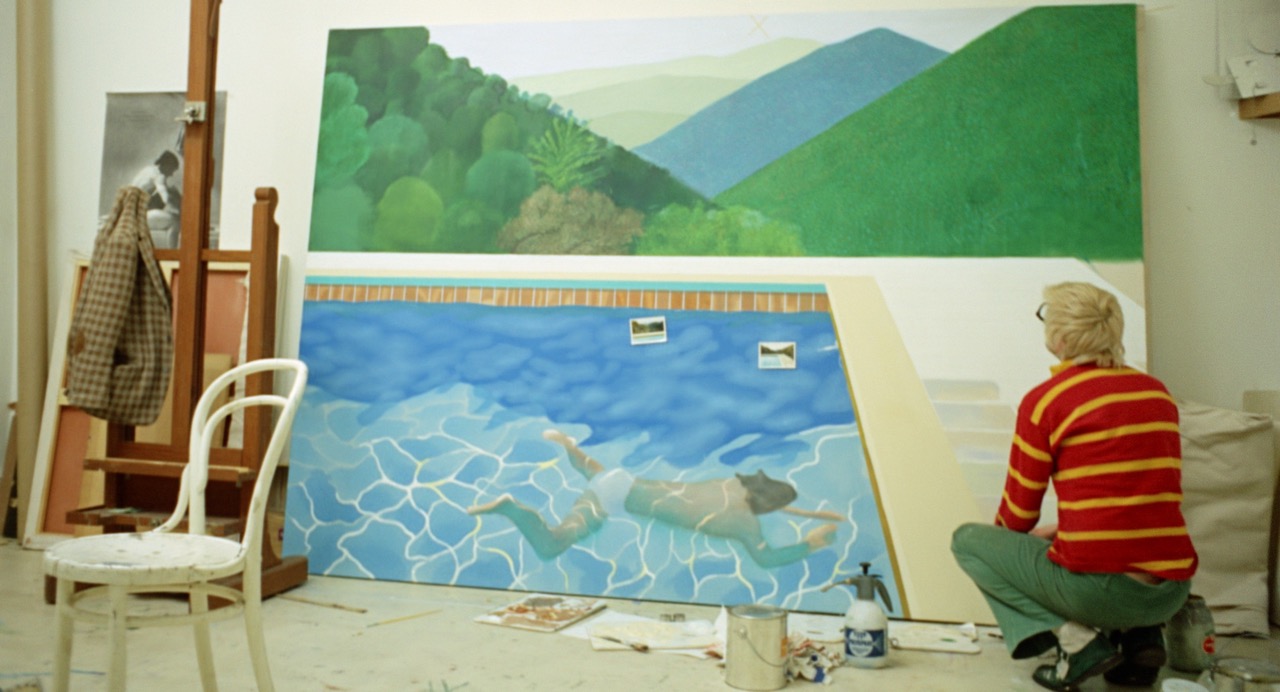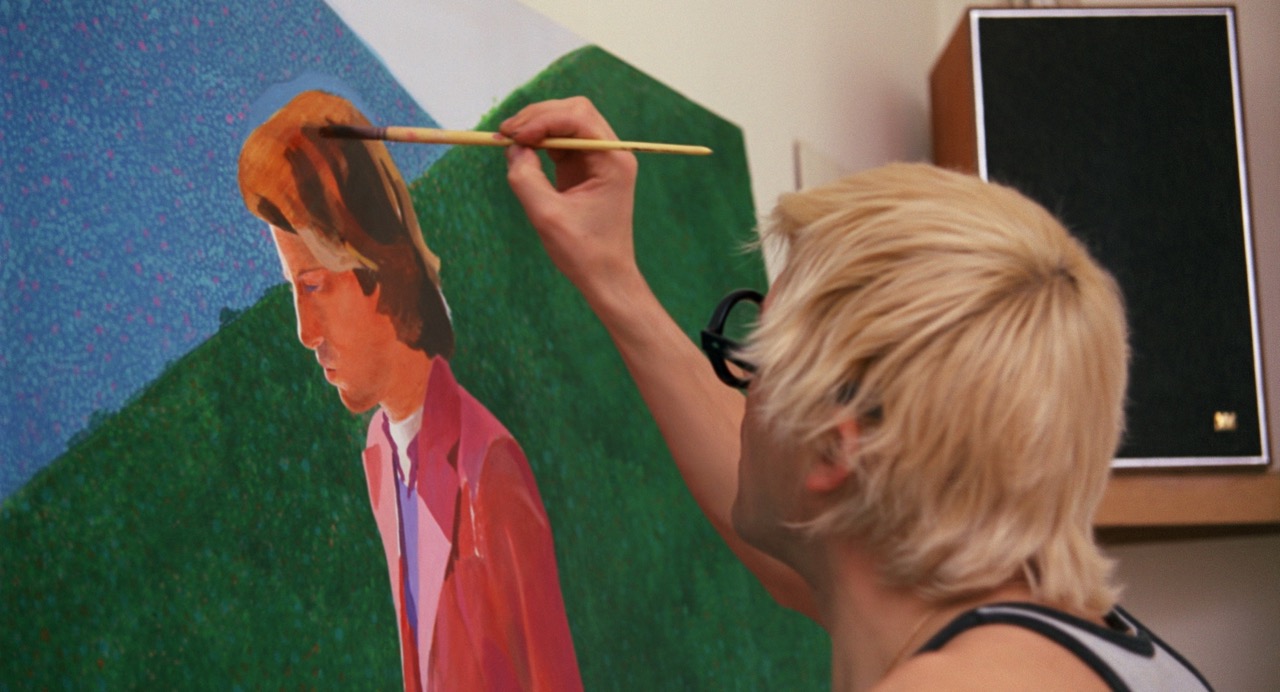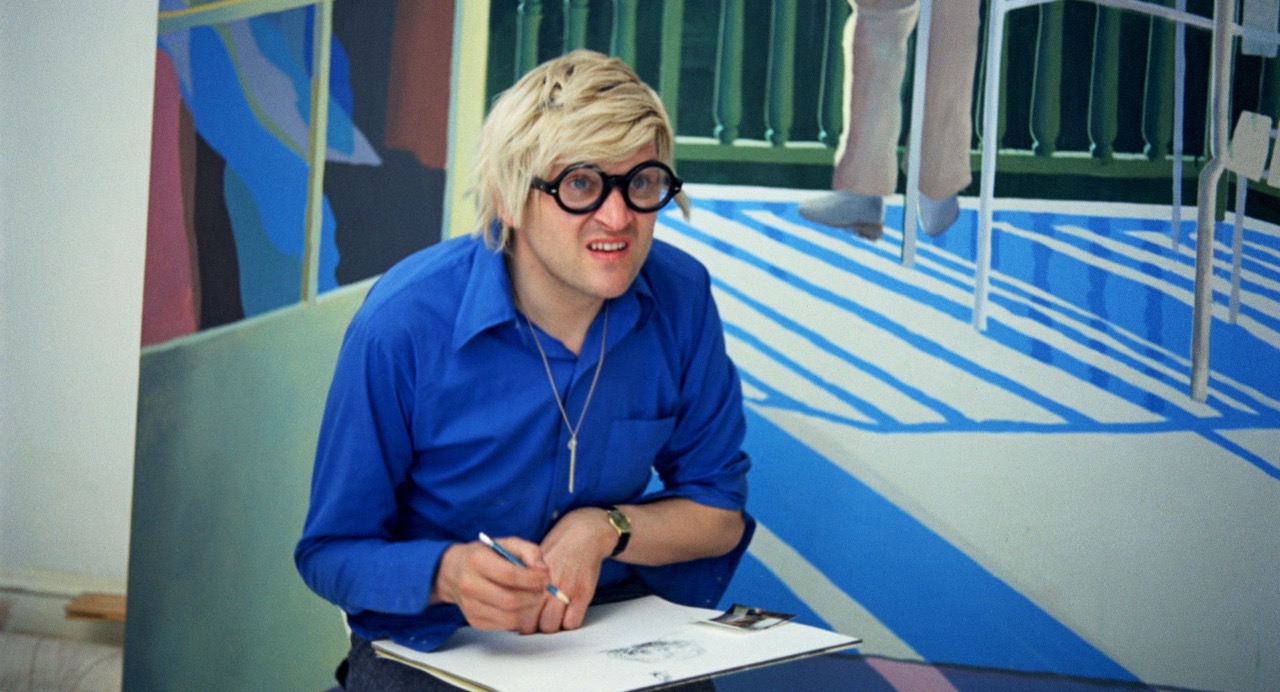 Ed Halter
Ed Halter
“When love goes wrong”: director Jack Hazan captures David Hockney and his early-1970s world.

David Hockney at work on Portrait of an Artist (Pool with Two Figures) in A Bigger Splash. Image courtesy Metrograph Pictures.
A Bigger Splash, directed by Jack Hazan, Metrograph, 7 Ludlow Street, New York City, through June 30, 2019
• • •
One of the most acute films made about a twentieth-century artist, Jack Hazan’s homoerotic docufiction A Bigger Splash (1974) takes its title from David Hockney’s signature 1967 painting depicting the momentary aftermath of a plunge into a Southern California pool, wherein a plume of displaced water stands frozen near the middle of the canvas, indicating the recent entry of an unseen diver. But the narrative of Hazan’s film centers on Hockney’s drawn-out struggle to create a different work, Portrait of an Artist (Pool with Two Figures) (1972). A visual sequel of sorts to the 1967 piece, the completed Portrait of an Artist also shows a sun-drenched modern American-style pool, now containing a briefs-clad male swimmer visible beneath its crystal waters, watched from above by a clothed man—modeled by Hockney’s erstwhile lover Peter Schlesinger—who stands nearby. As the film A Bigger Splash follows the disintegration of several interconnected relationships that transpire within the artist’s social circle, it is just as concerned with the evocation of depths through the contemplation of cool surfaces.

David Hockney at work on Portrait of an Artist (Pool with Two Figures) in A Bigger Splash. Image courtesy Metrograph Pictures.
And like the painting that grants the movie its title, Hazan’s project takes place in the wake of disruption. When Hockney finally granted Hazan permission to film what had been proposed as an experimental documentary on the artist and his closest associates, the painter was in the midst of a slow-motion breakup with the decade-younger Schlesinger. The film witnesses how the end of this relationship caused ripple effects to pulse through the interpersonal matrix of their friend group: Hockney’s devoted assistant and frequent model, Mo McDermott (who serves as something of a noir-style retrospective narrator in the film), grows nervous over Hockney’s notion of relocating to New York from London; McDermott himself seems to be at the tail end of coupledom with moody, glam-ish Mike Sida; fashion designers Celia Birtwell and Ossie Clark, seen as subjects of Hockney’s double portrait Mr and Mrs Clark and Percy (1970–71), teeter on the precipice of divorce. More than once during A Bigger Splash, McDermott provides an observation that might as well be the film’s tagline: “When love goes wrong, there’s more than two people suffer.”

Peter Schlesinger in A Bigger Splash. Image courtesy Metrograph Pictures.
Shot over a span of three years, from 1971 to 1973, in London, New York, and Southern California, A Bigger Splash can be interpreted as a torn-from-life metaphor for a buoyant 1960s maturing into the more disillusioned 1970s, a reading suggested as early as 1975 in an interview with Hazan in the British magazine Quorum. The surprisingly dreamlike quality of Hazan’s fantasy-actuality hybrid lends itself to this allegory; the reality Hazan seeks to capture is arguably more about conveying moods rather than biographical facts. In between observational scenes of the day-to-day life of the artist, Hazan interpolates a series of carefully composed visual asides that re-create aspects from Hockney’s paintings with their real-life subjects and settings, as well as sequences staged for hallucinatory eroticism: a full-frontal Hockney showering inside his azure-tiled bathroom; Schlesinger cavorting naked with three other lithe young men in yet another SoCal pool. Spontaneous moments are given additional dramatic weight when Hazan underscores a glance or a gesture with ominous, almost Hitchcockian music.
Despite the compelling beauty of these fiction-bits, the documentary aspect of A Bigger Splash remains central to its effects. One of its primary pleasures, perhaps even more so with the passing of time, is the intimate peephole it provides into the private lives of now-historical art-world figures like Hockney, curator Henry Geldzahler, dealer John Kasmin, and others, who are both figuratively and literally laid bare for the camera in ways that remain remarkable even in the age of reality television. In this, Hazan continues what had by then become a minor tradition, indulging in the documentary penchant for picturing the lives of celebrities that was already visible in the direct cinema of the 1960s.

David Hockney in A Bigger Splash. Image courtesy Metrograph Pictures.
For though the pioneering work of filmmakers like D. A. Pennebaker and the Maysles is often remembered as a radical new poetics of pure uncontrolled existence, introducing an exacting formula for building compelling cinema out of otherwise quotidian stuff, many of the most influential films of the movement in fact gravitated toward documenting famous notables, figures who were already comfortable with having cameras and microphones thrust in their faces. Consider Pennebaker’s Dont Look Back (1967), which brought viewers on tour with Bob Dylan, or the Maysles’ explosive Rolling Stones concert film, Gimme Shelter (1970). In these cases, the dynamic is not about capturing otherwise unselfconscious characters on film, but negotiating savvy subjects who are already skilled at manipulating media toward their own ends, and thereby attempting to reveal something about them that might otherwise manifest only off the record. Paradoxically, direct cinema’s revolutionary goal of representing real life in ways that scripted fictions could not often depended on the collaboration of members of the celebrity class.
In the 1975 Quorum article, the interviewer seems to highlight this issue. “Why not, as one reviewer said, a gay dustman?” he asks. “He would be facing real problems that could be fodder for a film.” Hazan responds that he was “only interested in creative people,” but this answer seems to sidestep the interest in fame displayed in A Bigger Splash itself, which opens with a montage of press photos and newspaper articles on Hockney, framing him unambiguously as Britain’s most celebrated artist and gossip-column mainstay. By the time Hazan began filming, Hockney was already a seasoned veteran of on-screen appearances, figuring prominently in, for instance, Peter Whitehead’s Swinging London document Tonite Let’s All Make Love in London (1967), and serving as the subject of James Scott’s short Love’s Presentation (1968), in which Hockney can be seen creating a series of sensual, C. P. Cavafy–inspired etchings, some of which would reappear in the opening credits of Hazan’s film.

David Hockney in A Bigger Splash. Image courtesy Metrograph Pictures.
Experiencing A Bigger Splash’s commingling of celebrity with the everyday, and of mass media with high art, one cannot help but discern the long shadow of Andy Warhol. While Hockney, unlike Warhol, isn’t himself a filmmaker, Hazan reveals him as similarly lens-obsessed, at various times employing 35mm and Polaroid cameras, a PortaPak video rig, and an opaque projector in the process of making his paintings. More significantly, both Hockney and Warhol worked as high-profile agents for the insistence of an unabashed homosexuality in popular culture, though Warhol’s own relationships were never on display in the way that Hockney’s are here. In this regard, A Bigger Splash’s reworking of private sorrow into public image prefigures the Faustian bargain that gay culture has undergone, trading in an underground existence for cultural acceptance through the creation and dissemination of exemplary creative commodities, be they paintings or cinema.
Ed Halter is a founder and director of Light Industry, a venue for film and electronic art in Brooklyn, New York, and Critic in Residence at Bard College in Annandale-on-Hudson, New York. His collection From the Third Eye: The Evergreen Review Film Reader, coedited with Barney Rosset, was published in 2018 by Seven Stories Press.